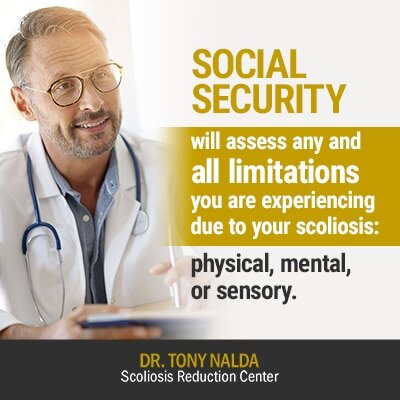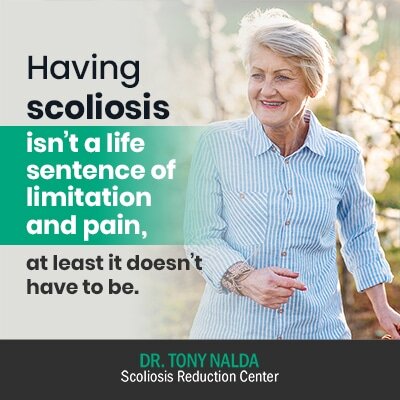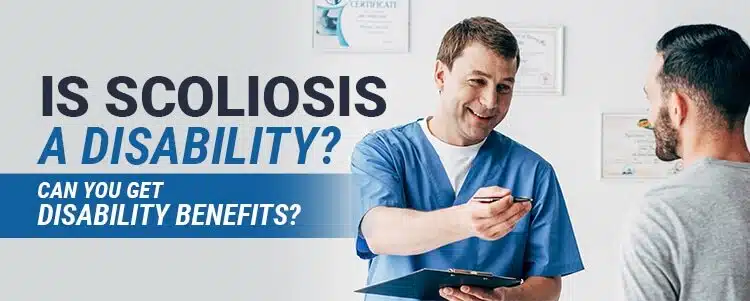If you are asking whether scoliosis is considered a disability or not, I assume you have recently been diagnosed and are concerned about your ability to work and quality of life. Although scoliosis is a progressive condition with no known cure, it develops across a wide severity spectrum, meaning some people have mild conditions, while others are moderate or severe. A person’s ability to work and enjoy life will depend greatly on the individual characteristics of their condition. The United States Social Services Administration (SSA) has a strict set of criteria that need to be met in order to collect Disability payments. Whether you meet those guidelines will depend on the level of your condition, related complications, and the work that you do.
Before we get into the SSA rules and regulations, let’s start by taking a look at the condition itself, its severity levels, and various forms. We’ll also spend some time discussing what it’s like to live with scoliosis and how this can affect work and quality of life.
What Exactly is Scoliosis?
As scoliosis is the leading cause of spinal deformity in the United States, let’s make sure we are all on the same page when it comes to understanding the nature of the condition itself.
Scoliosis is an abnormally curved spine. A person with scoliosis won’t have the same natural healthy curves as most people do; instead, their spine will curve to the side and coincide with rotation.
Scoliosis Severity
At the time of diagnosis and assessment, a measurement known as the Cobb angle will be taken via X-ray. The Cobb angle is taken by measuring the most-tilted vertebrae at the apex of the curve. This measurement tells us, in degrees, how far the spine deviates from a straight alignment.
The higher the Cobb angle, the more severe the condition is considered. From this, scoliosis will be classed as mild, moderate, or severe.
In order to be diagnosed as scoliosis, a person’s spine has to curve abnormally to the side, coincide with rotation, and have a Cobb angle measurement of 10+ degrees.
To put things in perspective in terms of severity range, scoliosis can be as mild as 10 degrees, and the largest curvature I’ve personally seen is 150 degrees. So you can imagine how the condition can vary within that huge range.
Who Develops Scoliosis?
The question of who develops scoliosis has another complex and far-ranging answer. Scoliosis can develop at any age, but it is most commonly diagnosed between the ages of 10 and 18. This is the condition’s most common form and accounts for a staggering 80 percent of diagnosed cases: adolescent idiopathic scoliosis (AIS).
The remaining 20 percent have known causes and are classed as congenital, neuromuscular, degenerative, or traumatic.
Congenital scoliosis: this form of the condition is present at birth and is caused by a malformed vertebra in the spine.
Neuromuscular scoliosis: this form of the condition is a secondary complication of a disease or condition that impairs the ability to control the muscles supporting the spine, such as cerebral palsy or muscular dystrophy.
Degenerative scoliosis: degenerative scoliosis is caused by degenerative changes to the spine, mainly in the discs that separate the vertebrae of the spine.
Traumatic scoliosis: traumatic scoliosis, as the name suggests, is scoliosis that develops due to a trauma experienced by the spine.
We’ve discussed the main forms that scoliosis can take so you can understand how many different severity levels and types of the condition there are.
When it comes to the SSA, whether or not scoliosis is considered a disability will depend on the condition, health, and work that the individual did prior to developing the condition.
Let’s go over some of the guidelines that the SSA has set in place to determine whether a person is eligible to receive Disability benefits.
Can You Get Social Security Disability (SSD) Benefits for Scoliosis?
The Supplemental Security Income and Social Security disability programs are in place to assist people with disabilities. They can provide an income, or supplemented income, source for people who are unable to work due to having a disability.
There are, however, strict stipulations and criteria that have to be met to be deemed eligible to receive Disability. In order to be eligible, a person has to prove two things: their condition meets the SSA’s definition of ‘disabled’ and that their condition renders them unable to work.
The Social Security Disability Insurance (SSDI) program pays benefits to people who have worked for a long enough current period and paid Social Security taxes on their earnings. If they meet both the non-medical and medical criteria and are considered to have limited alternative income resources, they might be paid monthly benefits.
One of the requirements is that the medical condition has to be shown to have lasted, or will last, at least an entire year, or result in death. In the context of scoliosis, we know that as a progressive incurable condition, the first stipulation will be met. It would be a very rare and an extreme case of scoliosis with the potential to result in death, so that stipulation would be harder to meet.
Is Scoliosis a Disability?
According to the SSA, there are a number of conditions and diseases that are considered a disability, but they have to be debilitating enough to prevent a return to work. They have the disabilities broken down into sections, and scoliosis would fall under the umbrella of ‘Musculoskeletal Disorders’.
In order for scoliosis to be considered a disability by Social Services, it has to meet the SSA’s definition of ‘disabled’:
- It would have to prevent you from doing the work you did before
- It would have to prevent you from doing other similar work
- Your scoliosis has lasted a year, or is expected to last a year, or result in death
The SSA has a comprehensive list of considered disabilities, and while there is no specific section for scoliosis, it would fall under Section 1.00 ‘Musculoskeletal System’ and then would be further specified in Section 1.04 under ‘Disorders of the Spine’.
While scoliosis doesn’t have its own listing, if it’s a severe enough case that causes significant issues with the spine, it can meet the requirements as a listed disorder of the spine.
Also, some severe scoliosis cases are known to cause related complications such as lung impairment and cardiovascular issues, so a person might also qualify for disability under the listings of ‘respiratory disorders’ or ‘cardiovascular disorders’.
In order to prove the seriousness of your condition as a ‘disability’, you would have to provide medical evidence documenting your condition from the time of diagnosis up to the time of your Disability application. This would likely include medical and insurance records, physical examinations, X-ray images, and any other pertinent information that proves the debilitating nature of your scoliosis.
Scoliosis and Work
As we’ve discussed, scoliosis takes many forms and varies widely in severity. For mild and moderate forms of the condition, the ability to work is rarely affected. In fact, one of the biggest challenges in treating adolescent idiopathic scoliosis is how difficult early detection can be.
Scoliosis rarely causes noticeable symptoms or pain in adolescents, except in severe cases, and this is why so many adolescents move through their youth with scoliosis, only to discover it in adulthood after having reached skeletal maturity.
Most forms of the condition carry few, if any, functional deficits, meaning it doesn’t significantly affect the ability to work or carry on with daily responsibilities. This, however, will vary greatly from patient to patient. Especially when it comes to scoliosis in aging adults, this is when complications tend to arise in the form of pain or mobility issues. Not only will the condition type and severity determine just how much, or how little, a person’s life will be affected by scoliosis, it’s also their overall health prior to developing the condition.
Obviously, a person who was in good health prior to developing the condition is less likely to be as affected by their scoliosis as a person who was in poor health.
When it comes to work, the more physical a job is, the more likely that a severe case of scoliosis that’s causing mobility issues might hamper that person’s ability to continue working.
In order to prove to the SSA that your scoliosis is preventing you from work, in addition to the medical information, you will need documentation from your workplace listing your daily responsibilities and how your condition has impaired your ability to perform them.

You will also need to provide information regarding other work you have done and why your scoliosis also prevents you from returning to that type of work.
Social Security will assess any and all limitations you are experiencing due to your scoliosis: physical, mental, or sensory. Using what’s known as a ‘residential functional capacity’ (RFC) form, they will determine if there is any other type of similar work you could be doing. Based on your condition, age, health, experience, and education, they will assess your ability to return to your current job, or find other work.
Based on these findings, and the medical information provided, they will determine your ability to work and the amount of monthly benefits, if any, you are entitled to.
Keep in mind, this article is according to Social Security Disability requirements in the United States. People with scoliosis in other countries will have to seek out their country’s own guidelines and criteria requirements.
Also, rules and regulations regarding how long a person has to work or how much they have to have paid into Social Security can change from year to year, so be sure any information you are reading is current, up to date, and relevant to your situation.
Scoliosis and Quality of Life
While we have discussed classifying scoliosis as a disability in terms of receiving government assistance, I have to be clear that I think perspective on scoliosis is very important.
As I explained, there are most certainly people who suffer with their condition or related complications, but there are just as many, if not more, in active treatment, who don’t experience notable functional deficits and life limitations. These people have adapted to life with their condition and are actively working to reduce their curvature and related symptoms along with it.
I like to mention Usain Bolt, the world’s fastest man. Many people don’t realize that Usain has scoliosis; yet, he was able to gain that title with his condition. Would you consider him disabled, or just living his best life with his condition?

So many of our experiences are guided by our perspective on our situation. If a person sees themselves as limited and disabled, no amount of evidence to the contrary can change that.
This is, in part, why I wrote Scoliosis Hope: to change the narrative surrounding peoples’ scoliosis story. Having scoliosis isn’t a life sentence of limitation and pain, at least it doesn’t have to be.
With our conserative treatment here at the Scoliosis Reduction Center®, we use a multi-faceted approach to treating scoliosis through a customized combination of scoliosis-specific chiropractic, therapy, rehabilitation, and corrective bracing.
Together, we work with our patients to design an approach that allows them to keep living their best lives and doing the things they love.
Our goal is to address the structural issue of the curvature first and foremost, and then move on to guiding our patients in adjusting to life with their condition in a positive and sustainable way.
To learn more about our conservative approach to scoliosis treatment, click here to contact us and get started.
Conclusion
Whether or not scoliosis is considered a disability in the eyes of the Social Services Administration will depend upon a number of variables regarding each applicant’s condition.
As scoliosis ranges so much in severity and form, the answer will differ case by case. For those living in the United States, in order to receive Disability benefits, they will have to meet a number of criteria regarding how long they have worked/what they’ve paid into Social Security, being unable to work due to their condition, and proving that their condition meets the SSA’s definition of ‘disability’.
Based on my experience of treating scoliosis, in the vast majority of cases, people engaging in active treatment can continue with their work and maintain a positive quality of life. In extreme cases, this can be different, but in average mild and moderate forms of the condition, debilitating functional deficits are less common.





